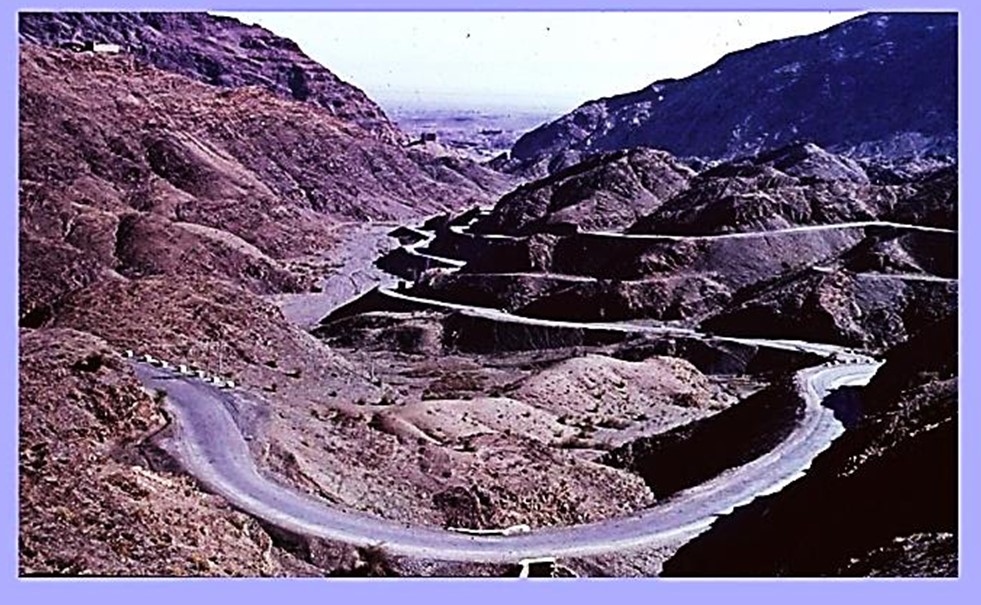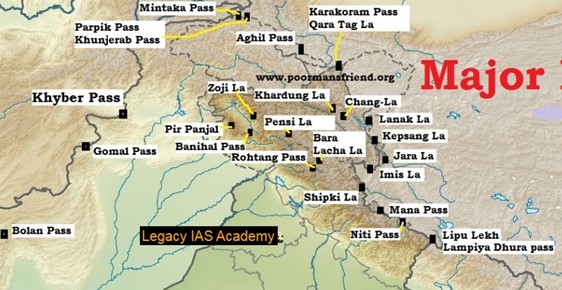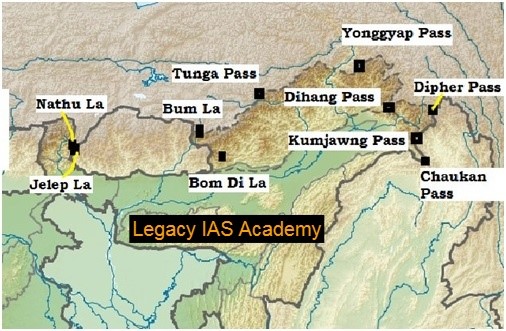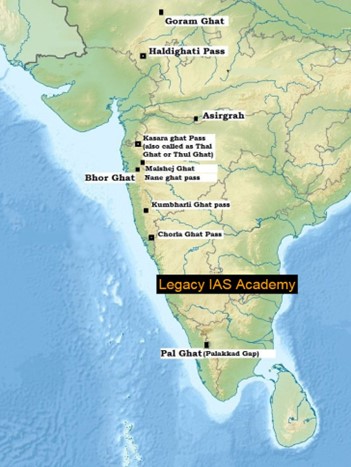A pass is a gap, or break, in high, rugged terrain such as a mountain ridge. It can be formed due to glacial movement or by rivers or as a result of gaps remaining since their formation.
Passes often provide the easiest routes for people to travel across steep mountain ranges. For this reason, they have played an important role throughout human history in migration, trade, and settlement.

Passes are good places to build settlements or defensive outposts because they are usually the only flat land in a mountainous area. This vantage point also makes a pass an easier location to defend against threats or enemies.
In some parts of the world, passes connect different cultures that are separated by the mountains between them. The Khyber Pass, which connects Pakistan and Afghanistan in the Hindu Kush mountains, has served as a key trade route between Central Asia and South Asia for thousands of years. Today, it is the route between the modern cities of Kabul, Afghanistan, and Peshawar, Pakistan.
The Historical Significance of Mountain Passes
The mountain pass has a rich history of inhabitation and crossing. In medieval times, the Himalayan mountain passes used to be the major trade routes of the South- Asian countries.
The great Himalayan passes were the means through which a larger part of the Indian subcontinent along with Nepal, India, Pakistan, Bangladesh, and Bhutan was connected to the rest of the world. These routes were used for the trading of silk, spices, and other goods. Karakoram Pass (Jammu & Kashmir) was part of the ancient Silk Route active in the early history of Asia.
The route, however, has remained one of the highest trade routes in the world. In contemporary times, Nathu la pass retains its significance for the passage of trade in the region and acts as an important trade route giving passage between India and China.
Haldighati Pass in Rajasthan is said to be the historic location of the ‘Battle of Haldighati’ between the Mewar king Maharana Pratap and the Mughals under Emperor Akbar in 1576.
Also, it has been a shelter for various tribal populations. For example, the Brahui of the Kurd ethnic group reside in Bolan pass and are still residing in the contemporary Balochistan province in Pakistan. The Khyber pass is occupied by Pushtuns or Pathans, quite violent mountain clans that speak the Pushtu language.
Importance of Mountain Passes In The Present Day
Enhancing Border Bonnectivity
From construction of roads, tunnels, and bridges to early opening of mountain passes despite formidable terrain and weather challenges, India has worked on a war-footing over the last year to ensure swifter mobility of its troops and weapon systems in forward areas amidst the continuing military confrontation with China in eastern Ladakh. Apart from offering relatively easy travel between valleys, passes also provide a route between two mountain tops with a minimum of descent
Promote Tourism
The roads nearby and through the passes has sights that are extremely picturesque and scenic and offer spectacular sceneries. Khardung La pass is located near the town of Leh and holds the distinction for having the highest motorable road in the world passing through it and every year especially in the summer months, numerous tourists come to Khardung La to witness the scenery and experience its mountain road. Thus tourism can be one of the main sources of income for the people.
Cultural Significance
The mountain pass is used by pilgrims in their route to the pilgrimage site. Eg: The Lipu Lekh Pass is located in the Himalayan Range in the state of Uttarakhand is used by the pilgrims to reach Kailash-Mansarovar.
Strategic Significance
There is a significant military presence of troops from both India and China in the areas around the mountain pass with many checkposts among the tall mountain tops. We often see in the news about clashes between Indian and Chinese troops at Nathu La(near Sikkim) which is at a strategic location along the Line of Actual Control(LAC). They serve as a major site for armed forces.
Geographic Significance
Mountain pass can be a water divide and also be a source of many rivers which support the livelihood needs of the downstream population. The Tsomgo (Changu) Lake near Nathu la pass is a major tourist attraction.
Source of Rich Biodiversity
Most of the Mountain passes are rich in Biodiversity and the terrain can be densely forested with many medicinal plants and a variety of faunas. Eg: Goram Ghat which is located in the Aravali Range in the state of Rajasthan is densely forested with Dhok forest and is known for its rich biodiversity.
Mountain Passes in North India

Bolan Pass:
- The Bolan Pass is famous for its tactical location. This is the reason why businessmen, attackers, and migratory clans have used the Bolan Pass as an entryway to and from South Asia.
- This pass was the original entranceway to India till it was replaced by the Khyber Pass, and offered a way for trade and commerce for the traders and businessmen of Afghanistan and Central Asia
The Khyber Pass:
- It is a mountain pass, which joins Afghanistan and Pakistan. The pass is lying at an elevation of 1,070 m or 3,510 ft. Since very old times, the Khyber Pass has been used as a crucial branch of the historic Silk Road.
- It functioned as a significant route for business between Central Asia and South Asia. The Khyber Pass also serves as a major site for armed forces.
Zoji La Pass
- It is in the Zaskar range of Jammu & Kashmir. The road route from Srinagar to Leh goes through this pass. It has been created by the Indus River.
Banihal Pass
- It is in Jammu & Kashmir. The National Highway NO.1 A that links Srinagar to Jammu goes through it. It has been created by the Indus River.
Shipki La Pass
- It is in Himachal Pradesh. The road from Shimla to Tibet goes through this pass. The Satluj River flows through this pass.
Bara-Lacha Pass
- It is also in Himachal Pradesh. It links Mandi and Leh by road.
Rohtang Pass
- It is also in Himachal Pradesh. It cuts through the Pir Panjal range. It links Manali and Leh by road.
Mana Pass
- It is in Uttarakhand. The land route to the Kailash and the Manasarovar passes through it.
Niti Pass
- It is also in Uttarakhand. The road to the Kailash and the Manasarovar passes through it.
Mountain Passes in North-East India

- Nathu La (Pass) – It is in Sikkim. It gives way to Tibet from Darjeeling and Chumbi valley.
- Jalep La pass : It is also in Sikkim and gives way to Bhutan. The Tista River has created this pass.
- Dihang pass: It is in Arunachal Pradesh- Mandalay.It is located in the Northeastern states of Arunachal Pradesh. This pass connects Arunachal Pradesh with Myanmar (Mandalay). At an elevation of more than 4000 m, it provides passage.
- Diphu pass: Arunachal Pradesh- Mandalay. Diphu Pass is a mountain pass around the area of the disputed tripoint borders of India, China, and Myanmar. Diphu Pass is also a strategic approach to eastern Arunachal Pradesh. It lies on the McMahon Line.
Mountain Passes In The Western and Southern India

Bhor Ghat:
- Bhor Ghat or Bor Ghat or Bhore Ghaut is a mountain passage located in Maharashtra, India situated on the crest of the Western Ghats.
- It is located at an elevation of four hundred and forty-one meters elevation above sea level. The ghat has a bit of historical evidence.
- The ghat was the ancient route developed by Satavahana to connect the ports of Choul, Revdanda Panvel, etc. on the Konkan coast and the surrounding areas on the Deccan plateau. Today the ghat plays a massive part of the Great Indian Peninsula Railway laid from Mumbai to Pune.
Thal Ghat:
- Thal Ghat is a ghat section (mountain incline or slope) in the Western Ghats near the town of Kasara in Maharashtra.
- The Thal Ghat is located on the busy Mumbai–Nashik route, and is one of the four major routes, rail, and road routes, leading into Mumbai.
Pal Ghat:
- The Palakkad Gap is located in the Western Ghats between the states of Tamil Nadu and Kerala. India at an elevation of about 140 m.
- The mountain pass is located between Nilgiri Hills in the north and Anaimalai Hills towards the south. The mountain pass was an important instrument for human migration across India’s southern tip throughout settled history.
Since many of the world’s mountain ranges have presented formidable barriers to travel, passes have played a key role in trade, war both human and animal migration throughout Earth’s history. Passes being places for trade routes, communications, cultural exchange, military expeditions has immense significance to date.
The Following Table Lists Various Mountain Passes in India
| Name | State | Height (ft) | Between/ Separating |
| Asirgarh | Madhya Pradesh | ||
| Auden’s Col | Uttarakhand | 17,552 | |
| Banihal Pass | Jammu and Kashmir (Jammu, Kashmir) | 9,291 | Jammu & Kashmir |
| Bara-lacha-la | Himachal Pradesh | 16,400 | |
| Bomdila | Arunachal Pradesh | ||
| Changla Pass | Jammu and Kashmir (Ladakh) | 17,585 | Leh & Changthang |
| Chanshal Pass | Himachal Pradesh | 14,830 | |
| Dehra Compass | Jammu and Kashmir (Ladakh) | ||
| Debsa Pass | Himachal Pradesh | 17,520 | |
| Diphu Pass | Arunachal Pradesh | 4,587 | |
| Dongkhala | Sikkim | 12,000 | |
| Fotu La | Jammu and Kashmir (Ladakh) | 13,451 | |
| Goecha La | Sikkim | 16,207 | |
| Haldighati Pass | Rajasthan | ||
| Indrahar Pass | Himachal Pradesh | 14,473 | |
| Jelep La | Sikkim | 14,300 | |
| Khardung La | Jammu and Kashmir (Ladakh) | 17,582 | Leh & Nubra |
| Kongka Pass | Jammu and Kashmir (Ladakh) | 16,965 | Ladakh & Aksai Chin |
| Lanak Pass | Jammu and Kashmir (Ladakh) | 17,933 | Ladakh & Tibet |
| Kunzum Pass | Himachal Pradesh (Lahaul and Spiti) | 14,931 | Lahaul & Spiti |
| Karakoram Pass | Jammu and Kashmir (Ladakh) | Ladakh & Xinjiang | |
| Lipulekh Pass | Uttarakhand | 17,500 | |
| Lamkhaga Pass | Himachal Pradesh | 17,336 | |
| Marsimik La | Jammu and Kashmir (Ladakh) | 18,314 | |
| Mayali Pass | Uttarakhand | 16,371 | |
| Nama Pass | Uttarakhand | 18,399 | |
| Nathu La | Sikkim | 14,140 | Sikkim & Tibet |
| Palakkad Gap | Kerala | 750 | Kerala & Tamil Nadu |
| Thamarassery Pass | Wayanad Kerala | 1,700 | Malabar & Mysore |
| Shenkottai pass | Kollam Kerala | 690 | Travancore & Tamil Nadu |
| Pensi La | Jammu and Kashmir (Ladakh) | ||
| Rohtang Pass | Himachal Pradesh | 13,051 | Manali & Lahaul |
| Sasser la | Jammu and Kashmir (Ladakh) | 17,753 | Nubra & Siachen Glacier |
| Sela Pass | Arunachal Pradesh | 14,000 | |
| Shipki La | Himachal Pradesh | ||
| Sia La | Jammu and Kashmir (Siachen Glacier) | 18,337 | |
| Shingo La | Jammu and Kashmir (Ladakh) | ||
| Spangur Gap | Jammu and Kashmir (Ladakh) | ||
| Gyong La | Jammu and Kashmir (Siachen Glacier) | 18,655 | |
| Bilafond La | Jammu and Kashmir (Siachen Glacier) | 17,881 | |
| Tanglang La | Jammu and Kashmir (Ladakh) | 17,583 | |
| Traill’s Pass | Uttarakhand | 17,100 | |
| Zojila Pass | Jammu and Kashmir (Kashmir, Ladakh) | 12,400 | Kashmir & Ladakh |





